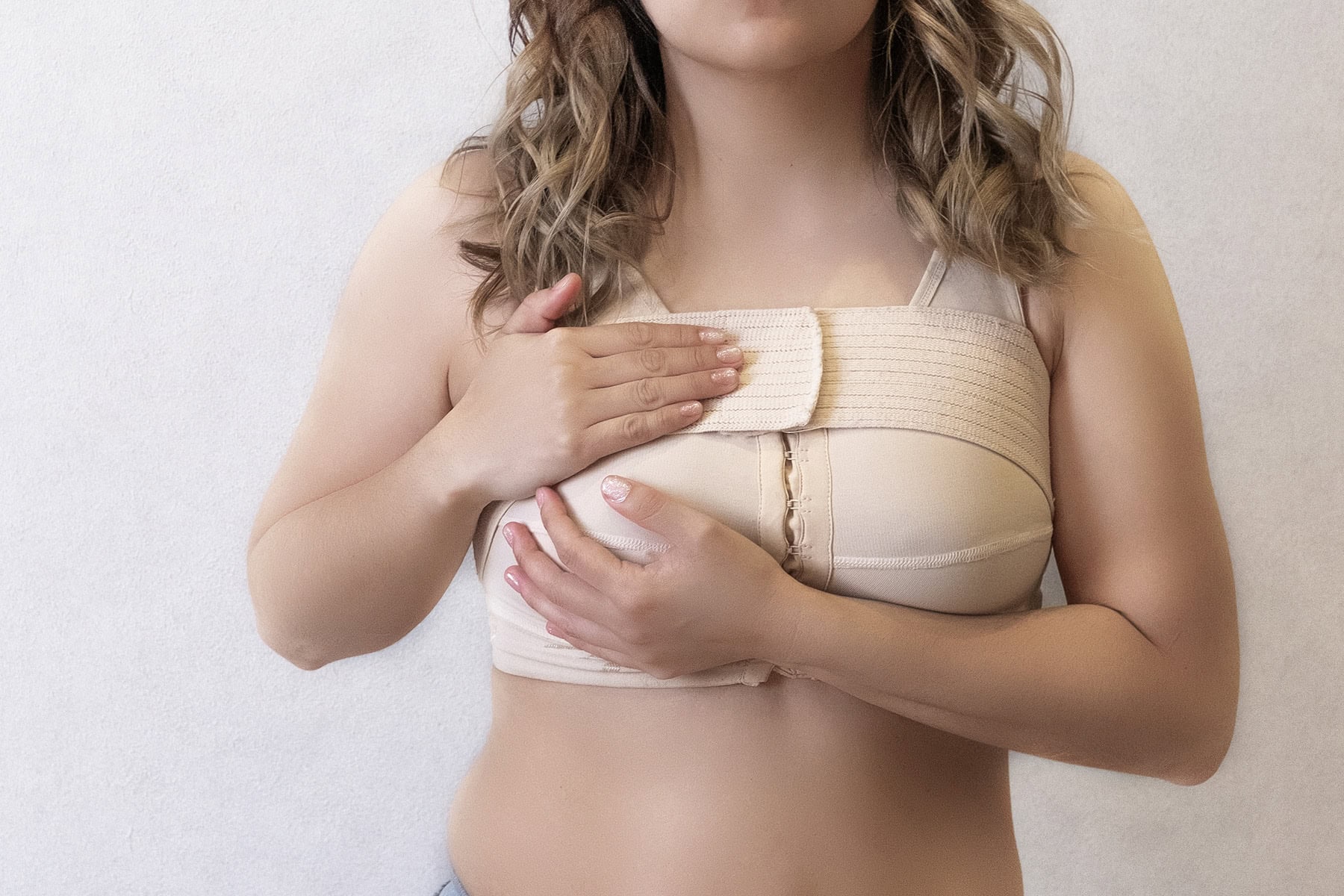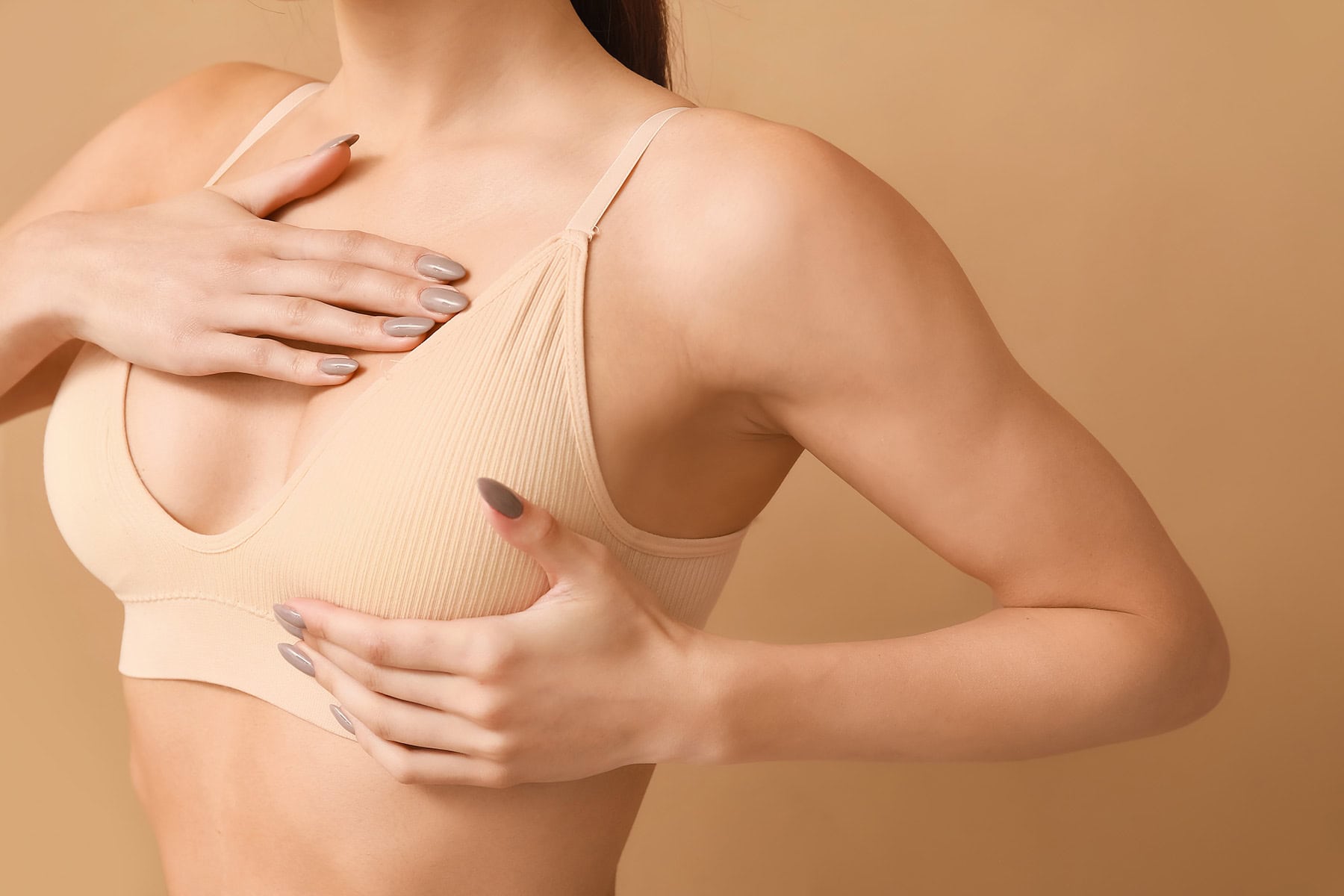Wondering what to wear after breast reduction surgery to ensure comfort and a smooth recovery?
Choosing the right clothing post-surgery is crucial.
You’ll need items like surgical bras, loose-fitting tops, and front-closure shirts to allow for proper healing.
This guide will walk you through the best clothing options for each stage of your recovery.
Key Takeaways
- Essential post-surgery clothing includes a surgical bra, loose-fitting attire, and front-closure tops to ensure comfort and support during recovery.
- As recovery progresses, transition to wire-free sports bras and eventually structured bras to accommodate changing needs while maintaining necessary support.
- Opt for breathable fabrics and minimal seam clothing to enhance comfort and prevent irritation during the healing process after breast reduction surgery.

Book Your Appointment
With Dr. Rovelo, a top plastic surgeon in Beverly Hills
Key Clothing Items for Immediate Post-Surgery
After breast reduction surgery, your body requires significant comfort.
It also needs ample support to facilitate recovery.
The right clothing can make a world of difference in your breast reduction recovery journey.
Dr. Rovelo recommends essential items like a surgical bra, loose-fitting clothing, and front-closure tops are crucial to wear after breast reduction.
These items not only provide the necessary support to the surgical area but also ensure maximum comfort and ease of movement, which is vital during the initial recovery phase at the surgical site.
Surgical Bra
A surgical bra is perhaps the most critical piece of clothing you will need after your breast reduction surgery.
This specialized post-surgical bra provides essential support, reduces swelling, and aids in the healing process.
It is designed to manage fluid buildup, improve circulation, and maintain breast shape.
Wearing a surgical bra continuously, except during showering, for at least several weeks post-surgery is highly recommended to ensure optimal recovery.
Loose Fitting Clothing
Loose-fitting clothing is another must-have in your post-surgery wardrobe.
Tight clothing can create discomfort and hinder the healing progress by restricting circulation and causing friction against incisions.
Opting for loose-fitting tops, such as front-closure tops or button-down shirts, ensures minimal strain and maximum comfort, allowing your body to heal properly.
Choosing breathable materials like cotton or linen further enhances comfort and reduces the risk of skin irritation.
Front Closure Tops
Front-closure tops are highly recommended for easy dressing after surgery.
These tops prevent straining muscles and protect sutures by eliminating the need to raise your arms above your head, which can be particularly painful and damaging during the initial recovery phase.
Front closures are an excellent option for this purpose.
Tops that close at the front also reduce pressure on sensitive areas, making them a practical and comfortable option for post-surgery wear.
Transitioning Through the Recovery Process

As your recovery progresses, your clothing needs will change.
Adjust your wardrobe to match the different stages of healing:
- The first few weeks: Choose clothing that supports initial healing and provides comfort.
- Mid-recovery: Select garments that accommodate ongoing healing needs.
- Beyond mid-recovery: Opt for clothing that ensures continued comfort and support.
Each phase requires specific clothing choices to support your healing and ensure comfort.
Enhanced healing, reduced swelling, and overall comfort are the goals during this recovery period.
First Few Weeks
During the first few weeks post-surgery, wearing a supportive compression bra is crucial.
This helps manage fluid buildup and reduces swelling.
Loose-fitting, front-closure tops are also beneficial for maintaining comfort and ease of dressing.
Avoid tight clothing that could restrict circulation or irritate healing areas, as it may impede the recovery process.
Clothing choices should be adjusted based on swelling and sensitivity levels.
Mid-Recovery (4-6 Weeks)
Around 4 to 6 weeks post-surgery, you can begin transitioning to wire-free sports bras.
These bras provide the necessary support while being more comfortable as your recovery progresses.
Soft, breathable materials are recommended during this stage to reduce skin irritation and enhance healing.
Long-Term Wear (3+ Months)
After 2 to 3 months, you can start wearing structured bras.
These new bras provide support and help highlight your new body shape.
Incorporating fitted clothing into your wardrobe can boost your confidence by complementing your new breast shape.
Regular bras can also be a comfortable option as you transition.
Even several months post-reduction, maintaining breathable fabrics in your wardrobe remains important for comfort, so you should continue wearing them.
Choosing the Right Bras During Recovery
Selecting the right bras during your recovery is crucial for comfort and support.
Compression bras, sports bras, and avoiding underwire bras are essential considerations.
These bras provide the necessary support while minimizing irritation and aiding the healing process.
Compression Bras
Compression bras (surgical bras) are vital after breast reduction surgery as they reduce swelling, protect sutures, and improve overall comfort.
Proper compression improves blood circulation, reduces swelling, and speeds up recovery, which are essential for minimizing postoperative complications.
Choosing the right size and features, such as adjustable straps and breathable fabrics, is crucial for comfort and proper support.
Sports Bras
As your healing progresses, you can transition to a well-fitted sports bra.
These bras:
- Provide sustained support
- Are suitable for the mid-recovery phase
- Help maintain breast shape and comfort
- Allow for more freedom of movement
Avoiding Underwire Bras
It’s essential to avoid underwire bras post-surgery (first 6 to 8 weeks) to prevent irritation at the incision sites.
Underwire bras can cause discomfort and hinder recovery by aggravating sensitive areas around the incisions.
Always check for the presence of wires in any post-surgical bra before making a purchase to ensure it provides the necessary support without causing irritation.
Tips for Comfortable Dressing After Breast Reduction
Comfort is key during breast reduction recovery from breast reduction surgery.
Opt for soft, breathable fabrics, easy-to-wear clothing, and items that minimize strain on your chest area.
These choices will enhance comfort, reduce irritation, and support the healing process.
Breathable Fabrics
Natural fibers like cotton or linen are optimal for post-surgery wear due to their breathability.
Choosing appropriate fabrics is crucial after breast reduction surgery to ensure comfort and support for breast tissue.
Breathable fabrics help minimize skin irritation and allow the skin to heal effectively, promoting a smoother recovery process.
Minimal Seams
Clothing with minimal seams can help reduce pressure and friction on sensitive areas post-surgery.
Garments with fewer seams prevent unnecessary pressure and irritation on the surgical area, improving overall comfort during the healing process.
Choosing minimal seam clothing is a vital aspect of enhancing comfort after surgery.
Button Down Shirts
Button-down shirts are ideal post-surgery because:
- They are easy to wear and reduce strain on the chest.
- They offer a practical solution for easy dressing without overexertion.
- They eliminate the need for overhead movements, aiding in a smoother recovery.
Planning Your Post-Surgery Wardrobe

Planning your post-surgery wardrobe is crucial for ensuring comfort, supporting healing, and preventing irritation of incision sites.
From pre-surgery shopping to monitoring changes and making long-term wardrobe adjustments, each step is important for a smooth recovery.
Pre-Surgery Shopping
Before your breast reduction surgery, consider ordering a variety of sizes in post-surgery bras to account for swelling.
Always check with your surgeon regarding their preference on surgical bras and your post breast reduction size chart.
Many times, a bra will be provided for you by the surgeon right after surgery.
Prioritize comfort, fit, and breathable fabrics when resuming a typical clothing routine post-surgery.
This preparation will help ensure you have the necessary items for a comfortable recovery.
Monitoring Changes
The swelling may take some time to subside.
Additionally, your breasts will gradually settle into their final shape and size after surgery, like a d cup size to a b cup size.
Track any swelling or discomfort to decide when to transition to regular clothes.
Gradually reintroduce regular clothing while keeping track of comfort levels.
It’s best to avoid tight-fitting garments until full healing has taken place.
Long-Term Wardrobe Adjustments
Updating your wardrobe post-surgery can help reflect the positive changes and even weight loss in your body.
Fitted clothing options can accentuate your new body shape, giving you confidence in your appearance.
Incorporating adjustable clothing can accommodate body changes over time after surgery, ensuring a comfortable clothing fit.
Additional Recovery Tips
In addition to clothing tips, there are other important aspects of recovery to consider.
Managing pain and discomfort, adhering to physical activity restrictions, and finding the best sleeping positions can all contribute to a smoother recovery process.
Proper clothing can reduce swelling and bruising, aiding in comfortable healing.
Managing Pain and Discomfort
Pain can be controlled during recovery using pain medications and compression clothing.
Cold compresses can be applied intermittently to reduce swelling post-surgery, helping to alleviate pains.
Ensure that ice is prepared by covering it with a cloth before applying it to the skin to prevent irritation.
Physical Activity Restrictions
Light walking is encouraged shortly after surgery to promote circulation and prevent blood clots.
Following physical activity restrictions is crucial for a smooth recovery after breast reduction surgery.
Engaging in light walking helps enhance circulation, which is important for healing and reduces the chances of complications.
Sleeping Positions
The recommended sleeping position during the initial recovery phase after breast reduction surgery includes:
- Keeping your breasts elevated by sleeping on your back in an elevated position
- Avoiding sleeping flat on your back, stomach, or side to enhance comfort and support healing
- Keeping the upper body elevated while sleeping to significantly enhance comfort
Placing a pillow under the torso can further enhance comfort while sleeping after surgery.
Summary
In summary, choosing the right clothing after breast reduction surgery plays a pivotal role in ensuring a comfortable and smooth recovery.
From immediate post-surgery essentials like surgical bras, loose-fitting clothing, and front-closure tops, to transitioning through various stages of recovery with appropriate bras and breathable fabrics, each step is important.
Long-term wardrobe adjustments that reflect your new body shape can boost your confidence and comfort.
Remember, your recovery journey is unique, so listen to your body and make wardrobe choices that support your healing and comfort.
Are you ready to begin your aesthetic journey with Dr. Rovelo?
Frequently Asked Questions
What type of bra should I wear immediately after breast reduction surgery?
You should wear a surgical bra immediately after breast reduction surgery for essential support, swelling reduction, and to facilitate the healing process. Prioritizing this will significantly aid your recovery.
Why is loose-fitting clothing recommended after breast reduction surgery?
Loose-fitting clothing is essential after breast reduction surgery as it minimizes strain and pressure on the chest, facilitating proper healing of the incisions. Prioritizing comfort can significantly aid in the recovery process.
When can I start wearing regular bras after breast reduction surgery?
You can typically start wearing regular bras two to three months after breast reduction surgery, provided you have healed properly and received your surgeon’s approval. Always follow your surgeon’s guidance for the best results.
Why should I avoid underwire bras during recovery?
You should avoid underwire bras during recovery as they can irritate incision sites and hinder your healing process. Opt for wireless or soft-cup bras to ensure comfort and support.
What are some tips for managing pain and discomfort after breast reduction surgery?
To effectively manage pain and discomfort after breast reduction surgery, consider using prescribed pain medications and applying cold compresses covered with cloth to reduce swelling. These strategies can significantly enhance your recovery experience.


